
The wrasses are a family, Labridae, of marine fish, many of which are brightly colored. The family is large and diverse, with over 600 species in 81 genera, which are divided into 9 subgroups or tribes. They are typically small, most of them less than 20 cm (7.9 in) long, although the largest, the humphead wrasse, can measure up to 2.5 m (8.2 ft). They are efficient carnivores, feeding on a wide range of small invertebrates. Many smaller wrasses follow the feeding trails of larger fish, picking up invertebrates disturbed by their passing. Juveniles of some representatives of the genera Bodianus, Epibulus, Cirrhilabrus, Oxycheilinus, and Paracheilinus hide among the tentacles of the free-living mushroom corals and Heliofungia actiniformis.
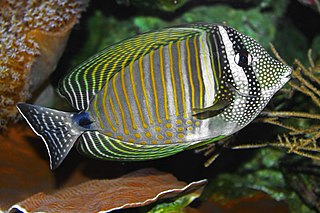
Zebrasoma desjardinii, the Red Sea sailfin tang, Desjardin's sailfin tang, Indian sailfin tang or Indian sailfin surgeonfish, is a species of marine ray-finned fish belonging to the family Acanthuridae, the surgeonfishes, unicornfishes and tangs. This fish is found in the Indian Ocean.

Coris is a genus of wrasses, collectively known as the rainbow wrasses, found in the Atlantic, Indian, and Pacific Oceans.
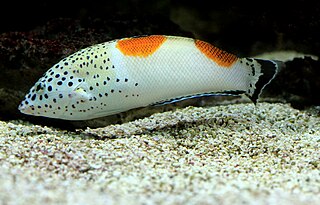
The clown coris, also known as the clown wrasse, false clownwrasse, humphead wrasse, hump-headed wrasse, red-blotched rainbowfish or twinspot wrasse, is a species of wrasse native to the Indian Ocean and the western Pacific Ocean.

The Christmas wrasse, also known as the ladder wrasse, green-barred wrasse or green-blocked wrasse, is a species of ray-finned fish, a wrasse from the family Labridae which is native to the Indian Ocean and the western Pacific Ocean. It inhabits shallow reefs at depths from the surface to 10 m (33 ft). It is of minor importance to local commercial fisheries and can be found in the aquarium trade.
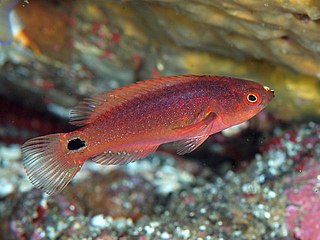
The exquisite wrasse is a species of ray-finned fish from the family Labridae, the wrasses, which is native to reefs in the Indo-West Pacific region. It can be found in the aquarium trade.

The striated wrasse, also known as the disappearing wrasse, pinstripe wrasse or scarlet wrasse, is a species of marine ray-finned fish from the family Labridae, the wrasses. It has a wide Indo-Pacific distribution. This species can also be found in the aquarium trade.

The queen coris, also known as the sand wrasse, Queen coris wrasse, Formosan coris, Formosa coris wrasse, Formosa wrasse, Indian Ocean wrasse or Indian sand wrasse, is a species of wrasse native to the Indian Ocean from the Red Sea and the coast of east Africa to Sri Lanka. This species appears in the aquarium trade due to its vibrant colors. A special feature about this species is how much they change from juvenile to adult form, in color, behaviour, and diet.

Coris gaimard, the yellowtail wrasse or African coris, among other vernacular names, is a species of wrasse native to the tropical waters of the central Indian Ocean and the western Pacific Ocean, from Christmas Islands and Cocos Keeling Islands to the Society Islands, Hawaii, and from Japan to Australia. It is an inhabitant of coral reefs, being found in areas that offer a mix of sand patches, rubble, and coral at depths from 1 to 50 m. This species can also be found in the aquarium trade and is popular species for display in public aquaria.

The slingjaw wrasse is a species of wrasse from the family Labridae which is native to the tropical waters of the Indo-Pacific where it occurs around coral reefs. This species is of minor importance to local commercial fisheries and can be found in the aquarium trade. Relatively mundane at first glance, this fish is notable for its highly protrusible jaws.
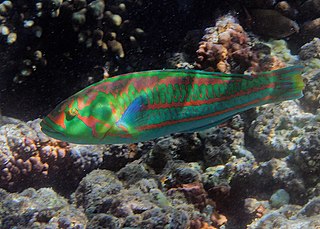
The surge wrasse, also known as the green-blocked wrasse, purple wrasse or red and green wrasse, is a species of wrasse native to the southeast Atlantic Ocean through the Indian and Pacific Oceans, where it inhabits reefs and rocky coastlines in areas of heavy wave action at depths from the surface to 10 m (33 ft). This species is of minor importance to local commercial fisheries, is popular as a game fish, and can be found in the aquarium trade.
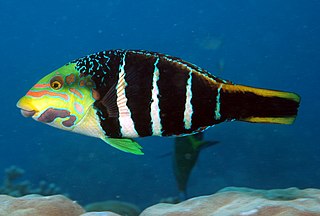
The barred thicklip wrasse is a species of fish belonging to the wrasse family, native from the Indo-Pacific.

The tubelip wrasse is a species of wrasse native to the Indian Ocean and the western Pacific Ocean. This species occurs in lagoons and on coral reefs at depths from 0 to 20 m. This species grows to 17.5 cm (6.9 in) in total length. It is of minor importance to local commercial fisheries and can be found in the aquarium trade. This species is the only known member of its genus.
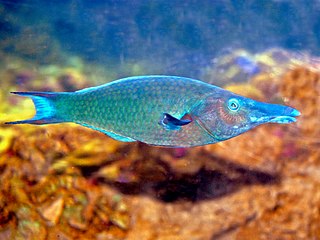
Gomphosus caeruleus, the green birdmouth wrasse, is a species of wrasse belonging to the family Labridae. It can be found in the aquarium trade.

Hologymnosus annulatus, the ring wrasse or ringed slender wrasse, is a species of marine ray-finned fish from the family Labridae, the wrasses, which has a wide Indo-Pacific distribution.
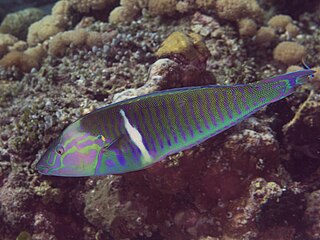
Hologymnosus doliatus, commonly called Pastel ringwrasse , is a marine ray-finned fish belonging to the family Labridae, the wrasses, which is found in the Indo-Pacific area.

Halichoeres scapularis, commonly called the Zigzag wrasse , is a fish species in the wrasse family native from the Indo-West Pacific.

Cymolutes praetextatus, the knife razorfish or knife wrasse, is a species of ray-finned fish from the family Labridae, the wrasses. It occurs in the Indo-Pacific where it occurs over reef flats and in shallow lagoons.

Pseudocoris heteroptera, the torpedo wrasse or zebra wrasse, is a species of marine ray-finned fish, a wrasse from the family Labridae. It is found in the western Pacific Ocean where it is associated with reefs.



















